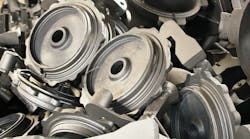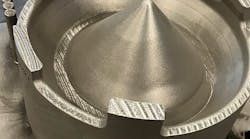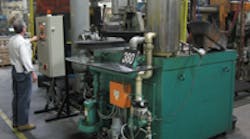The new recuperative furnace in operation at Empire Die Casting Co.
Recent, in-depth case studies have shown that metalcasters are able to cut in half the energy used for melting and holding aluminum and other nonferrous metals by replacing or upgrading less efficient furnaces. In one case study, a new, gas-fired furnace with an advanced insulation package and recuperative burner system was shown to reduce gas use by 50%. A second study demonstrated that retrofitting an existing electric resistance furnace with modern heating elements was able to generate a 60% reduction in average operating electric demand and an 18% reduction in the average weekly kilowatt hours used.
NADCA Gas-Fired Furnace Study
In a carefully documented case study published in 2009 by the North American Die Casting Assn., Empire Die Casting Co. compared the operation of old and new gas-fired furnaces. Its new furnace was a 979-lb. capacity, recuperative, crucible furnace built by Morgan Molten Metal Systems. It replaced a similarly sized conventional furnace. Both were used to hold molten aluminum.
The new furnace’s recuperative technology used waste heat from the furnace exhaust to reduce overall fuel consumption, via a counter-flow heat exchanger that replaced the standard exhaust stack. The recuperator transferred waste heat in the exhaust gases to the combustion air entering the fuel burner. With air preheat values of up to 480o F, less fuel was needed to heat those gases to the required melting or holding temperatures.
This chart illustrates the recuperative heat recycling process.
By recovering a portion of the energy usually lost as waste heat, the recuperator makes a fuel-fired crucible furnace significantly more efficient. But, to produce meaningful savings, a recuperator has to be part of a fully integrated system for reducing energy use. For that reason, Empire’s new recuperative furnace was designed with the optimal selection of energy saving materials and components.
While most conventional furnaces were built to transfer heat to the crucible via convection and conduction, Empire’s new furnace was outfitted with a high-alumina panel system designed to maximize radiant heating of the crucible. This is important because in a crucible furnace more than 60% of heat energy is transferred to the crucible through radiation. These panels also distribute radiant energy evenly throughout the furnace chamber.
The dense refractory panels incorporate raised nodules that create a large surface area to maximize radiant energy transfer to the crucible. Radiant energy is distributed more effectively and requires less energy input.
The combustion chamber was backed with technologically advanced insulating materials to reduce heat loss through the furnace sides and increase overall thermal efficiency.
Conventional fuel burners are either fully on or off. Temperature levels are controlled by turning the burner on and off at intervals, often leading to temperature undershooting or overshooting. Empire’s new recuperative furnace, however, is equipped with a high-performance, low-NOX, fully proportioning, nozzle mix, gas burner whose operation is fully controllable. Like a kitchen stove, burner flame levels could be adjusted to any point between the high and low limits. By reducing temperature undershooting and overshooting, the proportional burner reduced gas consumption. A programmable controller with a digital display operated the proportional burner and efficiently maintained the metal temperature within precise limits.
Significant heat losses occur when a furnace cover is open. Covers that are difficult to operate often are not closed during idle periods, resulting in wasted heat and higher energy costs. Empire’s new furnace features an easy-to-operate, swing-aside cover that makes it convenient for workers to close when the furnace is idle.
Empire’s new furnace evaluation was configured as a side-by-side, on-the-job comparison with a comparable existing furnace operating in its shop. Its primary focus was gas usage. During the evaluation period, Empire measured the natural gas used in both the new furnace and the conventional furnace on an hourly basis with a portable gas meter. The type of alloy, the alloy temperature and particular parts cast also were documented on an hourly basis. The evaluation included both casting production and idle periods.
The results revealed that during casting production periods, the new recuperative furnace used significantly less gas than the conventional furnace. The new recuperative furnace averaged about 135 cubic feet of gas use per hour, while the conventional furnace averaged about 305 cubic feet of gas use per hour. This represented a 55% reduction in gas use.
Retrofitted heating panels feature elements that are firmly embedded in a dense refractory substrate able to withstand temperatures above 2,000°F.
The new recuperative furnace achieved similar gas savings during idle periods, due both to the efficiencies of its recuperative technologies and the furnace’s superior insulation. The new furnace used an average of 12 ft3 of gas per hour versus the conventional furnace average rate of 24 ft3 of gas per hr., for idle time. This was a 50% savings in gas use.
Empire’s projected annual gas cost savings were $8,127 for the single furnace, based on 48 weeks per year, with 2-shifts per 5-day work week.
Power Company Electric Resistance Furnace Study
In response to high power costs, many metalcasters using electric resistance furnaces have switched to off-peak melting and installed demand control systems. But, a highly effective and less disruptive operational option is to increase the overall efficiency of the furnaces themselves. This can be accomplished either through the purchase of more efficient furnaces or by retrofitting existing furnaces with highly-efficient and durable heating panels backed by advanced insulation.
A major West Coast power utility produced a study in 2009 demonstrating the power-saving advantages of retrofitting inefficient existing electric resistance furnaces with features designed to increase the furnaces’ thermal and power handling efficiency. This study was initiated as part of a financial incentive program to assist the utility’s industrial customers to select productivity enhancing and power-saving investments.
The baseline study was conducted at a foundry producing aluminum, brass and bronze castings, ranging up to 6,000 lbs. for aluminum and 400 lbs. for brass/bronze. It involved retrofits for two of its five existing 1200 lb. capacity electric resistance furnaces used for holding molten metal 24/7. These retrofits were provided by Morgan Molten Metal Systems and included new resistance heating panels, a new wiring configuration and advanced insulation to reduce heat loss through the furnace walls. Unlike conventional, fiber-backed element panels that are subject to shorts caused by wire slump, the element panels used for the retrofit embedded the heating elements in a dense refractory substrate able to withstand temperatures above 2,000oF. The panels also featured high thermal conductivity to protect the wire from overheating. Unlike the conventional panels, these new panels were wired to isolate any electrical damage to a single panel, reducing cool zones and increasing overall service life.
During evaluation, the performance of each of the two furnaces was carefully measured and logged for a week prior to the retrofit and for a week after completion of the retrofit. Prior to the retrofit, average operating demand was 60.2 kW. But, that figure dropped to just 24.3 kW after the retrofit for an average operating demand reduction of 60%. Average weekly kilowatt-hours for each furnace were cut from 2,798 kWh before the retrofit to 2,298 after, an 18% savings. Annualized, that was a 50,000 kWh savings for both furnaces.
Overall, the study projected an annual savings in electricity costs of $4,200 for each furnace after the retrofit and a simple investment payback period of 1.5 years, including the power utility’s incentive payments to the foundry based on the furnace’s projected energy savings.
Mark Lamoureaux is president of Morgan Molten Metal Systems. Visit www.morganmms.com













